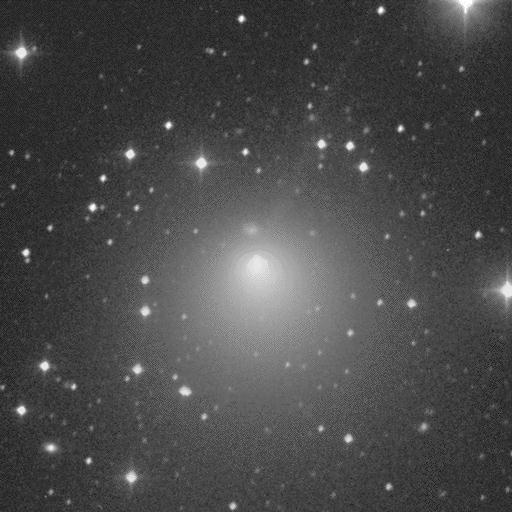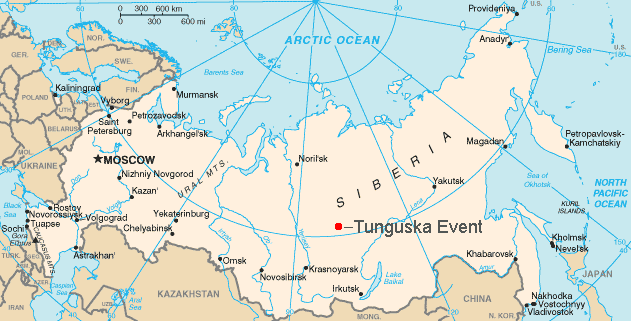|
Taurid
The Taurids are an annual meteor shower, associated with the comet Encke. The Taurids are actually two separate showers, with a Southern and a Northern component. The Southern Taurids originated from Comet Encke, while the Northern Taurids originated from the asteroid 2004 TG10, possibly a large fragment of Encke due to its similar orbital parameters. They are named after their radiant point in the constellation Taurus, where they are seen to come from in the sky. Because of their occurrence in late October and early November, they are also called Halloween fireballs. Since 2P/Encke is such a short period comet, the meteors have the slowest impact speed of the annual well-known meteor showers. Comet Encke and the Taurid complex are believed to be remnants of a disrupted 40-km-class comet from about 10,000 years ago, breaking into several pieces and releasing material by normal cometary activity, mass loss via YORP spin-up, or occasionally by close encounters with the ti ... [...More Info...] [...Related Items...] OR: [Wikipedia] [Google] [Baidu] |
Beta Taurids
The Beta Taurids (β–Taurids) are an annual meteor shower belonging to a class of "daytime showers" that peak after sunrise. The Beta Taurids are best observed by radar and radio-echo techniques. The Beta Taurids are normally active from June 5 to July 18. They emanate from an average radiant of right ascension 5h18m, declination +21.2 and exhibit maximum activity around June 28–29 (Solar Longitude=98.3 deg). The maximum hourly rate typically reaches about 25 as seen on radar. Non-radio observers are faced with a very difficult prospect, because the Beta Taurid radiant is just 10–15 degrees west of the Sun on June 28. These Beta Taurids are the same meteoroid stream as the Taurids (which form a meteor shower in late October). The Earth intersects this stream of debris twice, once in late October and once in late June, forming two separate meteor showers. However, because the October event occurs at night, it is far more visible and better known than the Beta Taurids, whic ... [...More Info...] [...Related Items...] OR: [Wikipedia] [Google] [Baidu] |
Comet Encke
Comet Encke , or Encke's Comet (official designation: 2P/Encke), is a periodic comet that completes an orbit of the Sun once every 3.3 years. (This is the shortest period of a reasonably bright comet; the faint main-belt comet 311P/PanSTARRS has a period of 3.2 years.) Encke was first recorded by Pierre Méchain on 17 January 1786, but it was not recognized as a periodic comet until 1819 when its orbit was computed by Johann Franz Encke. Like Halley's Comet, it is unusual in its being named after the calculator of its orbit rather than its discoverer. Like most comets, it has a very low albedo, reflecting only 4.6% of the light its comet nucleus, nucleus receives, although comets generate a large coma (cometary), coma and tail that can make them much more visible during their perihelion (closest approach to the Sun). The diameter of the nucleus of Encke's Comet is 4.8 km. Discovery As its official designation implies, Encke's Comet was the first periodic comet discovered af ... [...More Info...] [...Related Items...] OR: [Wikipedia] [Google] [Baidu] |
Taurus (constellation)
Taurus (Latin, 'Bull') is one of the constellations of the zodiac and is located in the northern celestial hemisphere. Taurus is a large and prominent constellation in the Northern Hemisphere's winter sky. It is one of the oldest constellations, dating back to the Early Bronze Age at least, when it marked the location of the Sun during the spring equinox. Its importance to the agricultural calendar influenced sacred bull, various bull figures in the mythologies of Ancient Sumerian religion, Sumer, Akkadian religion, Akkad, Assyrian religion, Assyria, Babylonian religion, Babylon, Ancient Egyptian religion, Egypt, Ancient Greek religion, Greece, and Religion in ancient Rome, Rome. Its old astronomical symbol is (♉︎), which resembles a bull's head. A number of features exist that are of interest to astronomers. Taurus hosts two of the nearest open clusters to Earth, the Pleiades and the Hyades (star cluster), Hyades, both of which are visible to the naked eye. At first magnitu ... [...More Info...] [...Related Items...] OR: [Wikipedia] [Google] [Baidu] |
Zeta Perseids
The Zeta Perseids (ζ–Perseids) are a daylight meteor shower that takes place from about May 20 to July 5. On the peak date of June 13, the radiant is only 16 degrees from the Sun. The shower was discovered at Jodrell Bank Observatory in 1947 using radio equipment. The Zeta Perseids and Beta Taurids are both probably associated with the Taurid Complex of meteor showers. The Arietids The Arietids are a strong meteor shower that lasts from May 22 to July 2 each year, and peaks on June 7. The Arietids, along with the Zeta Perseids, are the most intense daylight meteor showers of the year. The source of the shower is unknown, bu ... and Zeta Perseids maxima tend to blend into one another. References Meteor showers May June {{meteoroid-stub ... [...More Info...] [...Related Items...] OR: [Wikipedia] [Google] [Baidu] |
2004 TG10
, is an eccentric asteroid, classified as near-Earth object and potentially hazardous asteroid of the Apollo group. First observed by the Spacewatch survey on 8 October 2004, it may be a fragment of Comet Encke and is the source of the Northern Taurids meteor shower seen annually in November and the June Beta Taurids.Meteor showers and their parent cometpg 470by Peter Jenniskens The asteroid may be larger than one kilometer in diameter. Orbit orbits the Sun at a distance of 0.3–4.2 AU once every 3 years and 4 months (1,220 days). Its orbit has an eccentricity of 0.86 and an inclination of 4 ° with respect to the ecliptic. It has an ''Earth minimum orbital intersection distance'' of , which corresponds to 8.8 lunar distances. Physical characteristics According to the survey carried out by the NEOWISE mission of NASA's Wide-field Infrared Survey Explorer, the asteroid measures 1.316 kilometers in diameter and its surface has an exceptionally low albedo Alb ... [...More Info...] [...Related Items...] OR: [Wikipedia] [Google] [Baidu] |
Meteor Shower
A meteor shower is a celestial event in which a number of meteors are observed to radiate, or originate, from one point in the night sky. These meteors are caused by streams of cosmic debris called meteoroids entering Earth's atmosphere at extremely high speeds on parallel trajectories. Most meteors are smaller than a grain of sand, so almost all of them disintegrate and never hit the Earth's surface. Very intense or unusual meteor showers are known as meteor outbursts and meteor storms, which produce at least 1,000 meteors an hour, most notably from the Leonids. The Meteor Data Centre lists over 900 suspected meteor showers of which about 100 are well established. Several organizations point to viewing opportunities on the Internet. NASA maintains a daily map of active meteor showers. Historical developments A meteor shower in August 1583 was recorded in the Timbuktu manuscripts.Abraham, Curtis"Stars of the Sahara" ''New Scientist'', issue 2617,15 August 2007, page 39–41 I ... [...More Info...] [...Related Items...] OR: [Wikipedia] [Google] [Baidu] |
Tunguska Event
The Tunguska event was a large explosion of between 3 and 50 TNT equivalent, megatons that occurred near the Podkamennaya Tunguska River in Yeniseysk Governorate (now Krasnoyarsk Krai), Russia, on the morning of 30 June 1908. The explosion over the sparsely populated East Siberian taiga felled an estimated 80 million trees over an area of of forest, and eyewitness accounts suggest up to three people may have died. The explosion is attributed to a meteor air burst, the atmospheric explosion of a stony asteroid about wide. The asteroid approached from the east-south-east, probably with a relatively high speed of about . Though the incident is classified as an impact event, the object is thought to have exploded at an altitude of rather than hitting the Earth's surface, leaving no impact crater. The Tunguska event is the largest impact event on Earth in recorded history, though List of impact craters on Earth, much larger impacts are believed to have occurred in prehistoric ... [...More Info...] [...Related Items...] OR: [Wikipedia] [Google] [Baidu] |
Mars 1
Mars 1, also known as 1962 Beta Nu 1, Mars 2MV-4 and Sputnik 23, was an automatic interplanetary station launched in the direction of Mars on November 1, 1962, the first of the Soviet Mars probe program, with the intent of flying by the planet at a distance of about . It was designed to image the surface and send back data on cosmic radiation, micrometeoroid impacts and Mars' magnetic field, radiation environment, atmospheric structure, and possible organic compounds. After leaving Earth orbit, the spacecraft and the Molniya booster's fourth stage separated and the solar panels were deployed. Early telemetry indicated that there was a leak in one of the gas valves in the orientation system so the spacecraft was transferred to gyroscopic stabilization. It made sixty-one radio transmissions, initially at two-day intervals and later at five days, containing a large amount of interplanetary data. On March 21, 1963, when the spacecraft was at a distance of from Earth on its wa ... [...More Info...] [...Related Items...] OR: [Wikipedia] [Google] [Baidu] |
Anno Domini
The terms (AD) and before Christ (BC) are used when designating years in the Gregorian calendar, Gregorian and Julian calendar, Julian calendars. The term is Medieval Latin and means "in the year of the Lord" but is often presented using "our Lord" instead of "the Lord", taken from the full original phrase "", which translates to "in the year of our Lord Jesus Christ". The form "BC" is specific to English language, English, and equivalent abbreviations are used in other languages: the Latin (language), Latin form, rarely used in English, is (ACN) or (AC). This calendar era takes as its epoch (date reference), epoch the traditionally reckoned year of the annunciation, conception or Nativity of Jesus, birth of Jesus. Years ''AD'' are counted forward since that epoch and years ''BC'' are counted backward from the epoch. There is no year zero in this scheme; thus the year AD 1 immediately follows the year 1 BC. This dating system was devised in 525 by Dionysius Exiguus but was ... [...More Info...] [...Related Items...] OR: [Wikipedia] [Google] [Baidu] |
National Geographic (magazine)
''National Geographic'' (formerly ''The National Geographic Magazine'', sometimes branded as ''Nat Geo'') is an American monthly magazine published by National Geographic Partners. The magazine was founded in 1888 as a scholarly journal, nine months after the establishment of the society, but is now a popular magazine. In 1905, it began including pictures, a style for which it became well known. Its first color photos appeared in the 1910s. During the Cold War, the magazine committed itself to present a balanced view of the physical geography, physical and human geography of countries beyond the Iron Curtain. Later, the magazine became outspoken on Environmentalism, environmental issues. Until 2015, the magazine was completely owned and managed by the National Geographic Society. Since 2015, controlling interest has been held by National Geographic Partners. Topics of features generally concern geography, history, nature, science, and world culture. The magazine is well known ... [...More Info...] [...Related Items...] OR: [Wikipedia] [Google] [Baidu] |






